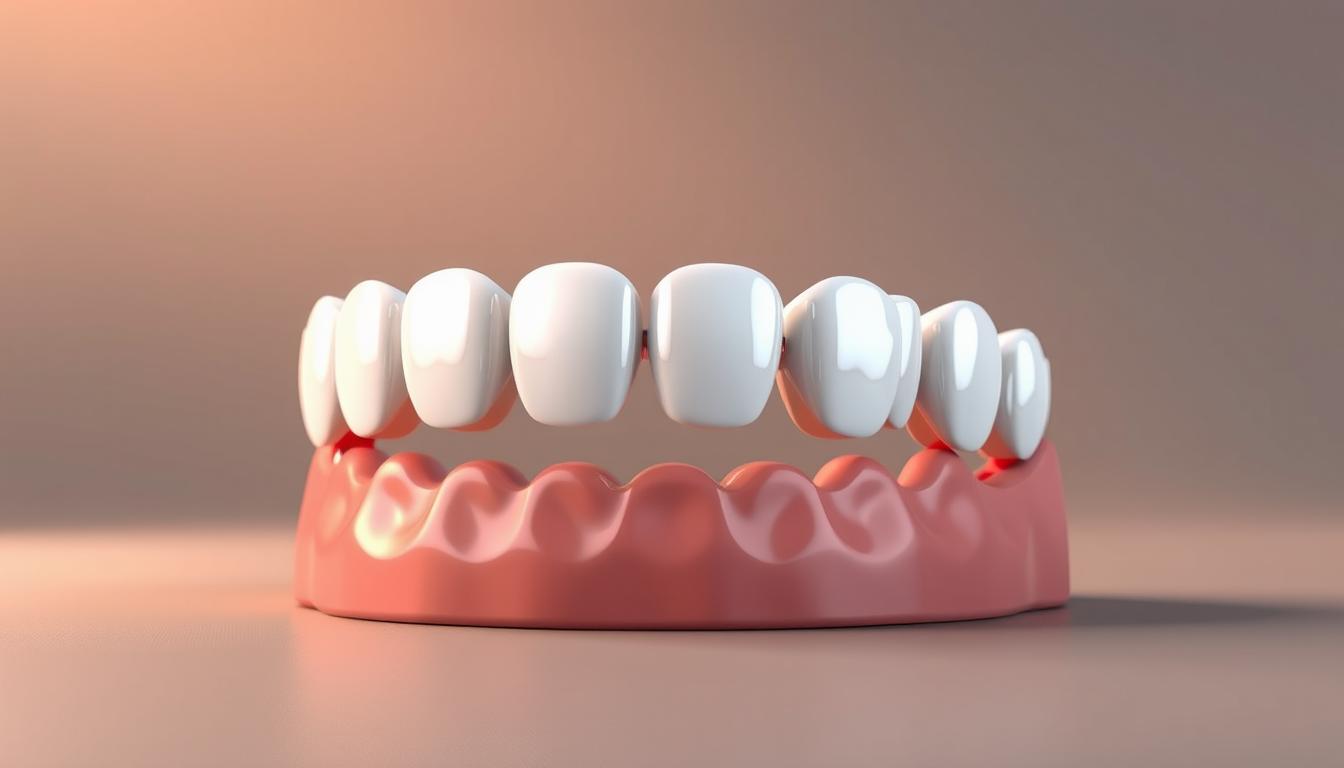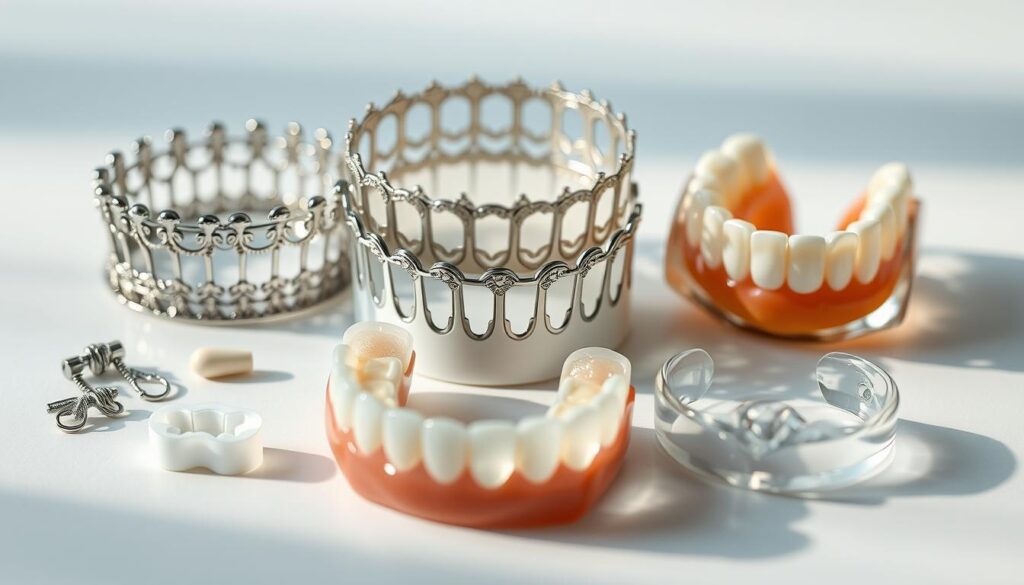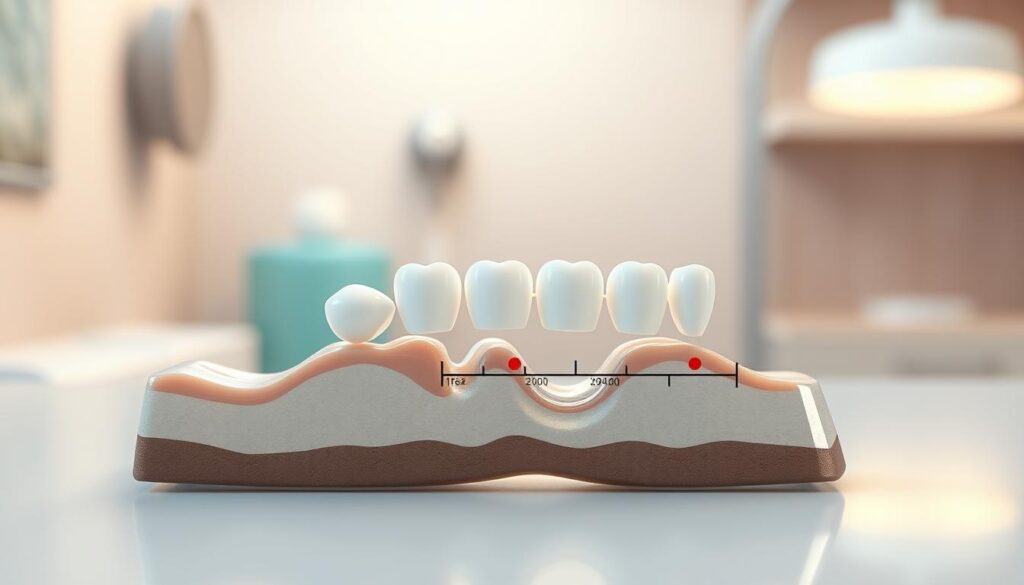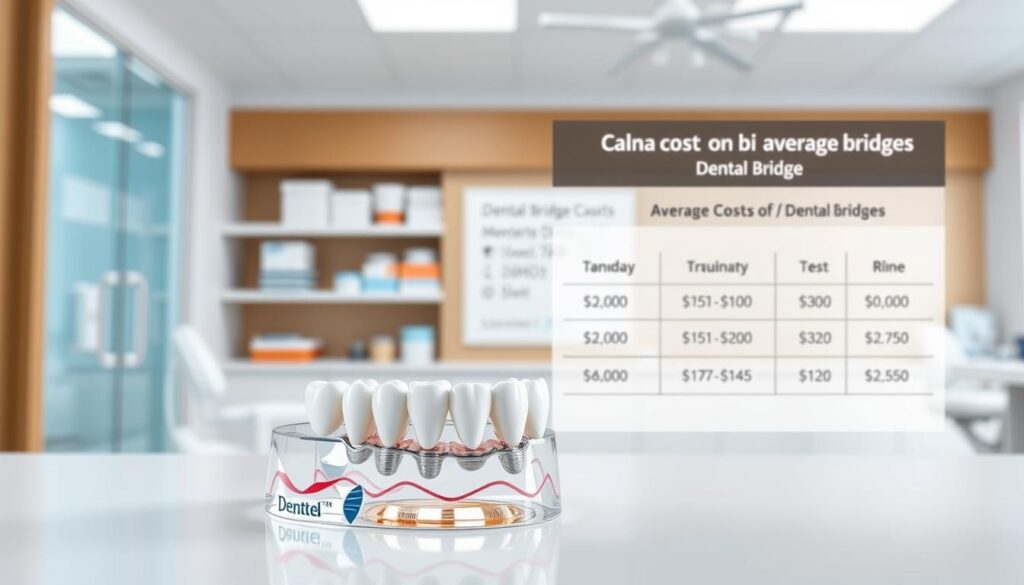What is a Dental Bridge, and How Does It Work?

Did you know nearly 120 million people in the United States have at least one missing tooth? This is according to the American College of Prosthodontists. It shows a common issue that affects our daily comfort and looks.
A dental bridge is a permanent fix for this problem. It connects a prosthetic tooth, called the pontic, to nearby teeth or implants. This method helps us chew better and keeps our bite in line, which lowers the chance of other problems.
Key Takeaways
- A dental bridge replaces one or several missing teeth with a fixed solution.
- The pontic tooth is secured by nearby abutment teeth or implants.
- This technique maintains function by stabilizing bite alignment.
- Natural appearance is restored while preventing shifting of adjacent teeth.
- Regular care and checkups support the bridge’s longevity.
Understanding Dental Bridges
Dental bridges are a popular choice for those who have lost teeth. They help restore a natural bite and keep the jaw aligned. People like them because they work well and look good too.
Definition and Key Elements
A bridge is a fixed solution for missing teeth. It connects artificial teeth to nearby teeth. This keeps the bite right and eases pressure on other teeth.
Types of Bridges
There are many types of bridges for different needs:
- Traditional: Uses two healthy teeth on either side of the gap.
- Cantilever: Relying on one tooth for support.
- Maryland: A bonded framework attached behind teeth.
- Implant-Supported: Uses titanium posts for extra stability.
How They Compare to Other Restorative Options
Bridges stay in place and prevent teeth from shifting. Implants offer similar strength but require more surgery. Each option fits different needs and budgets. Regular dental check-ups are key to their success.
The Functionality of Dental Bridges
Teeth do more than just chew food. They help keep our jaw stable and ensure our bite is right. When teeth are missing, it throws off this balance. Dental bridges fix this by filling in the gaps with a strong piece.
How Bridges Restore Missing Teeth
A bridge uses a well-fitting pontic to replace missing teeth. This lets people chew properly again. It also stops nearby teeth from shifting or tilting, keeping the mouth’s shape intact.
The Role of Abutment Teeth
Abutment teeth are the anchors for the bridge. Crowns on these teeth keep the bridge in place. This setup spreads out the pressure of biting, making it more comfortable and lasting longer.
Importance of Proper Alignment
How teeth line up affects everything from jaw posture to how we speak. If they’re not right, it can cause problems like bad bites and jaw pain. Getting the bridge to fit perfectly can improve chewing and keep the mouth healthy.
The Benefits of Dental Bridges
Dental bridges can change your life for the better. They help people feel more confident in their smiles. They also keep their teeth and jaws healthy.
Studies show that filling gaps can make your bite better. It can also stop problems that come from missing teeth.
“According to the American Dental Association, restoring missing teeth helps sustain the structural integrity of the mouth and can prevent long-term complications.”
Aesthetic Improvements
A good bridge looks just like your natural teeth. It’s made from materials like porcelain and ceramic. These materials match your tooth color and shape well.
This makes your smile look healthier. It helps you feel more confident in social and work situations.
Functional Advantages
A bridge makes chewing easier. It spreads out the pressure, so your teeth don’t get worn down. You can speak more clearly again.
Many people feel more comfortable eating different foods. They don’t have to worry about discomfort anymore.
Impact on Oral Health
- Prevention of shifting that may misalign tooth positions
- Support for surrounding tissues to maintain jaw stability
- Improved oral mechanics with fewer biting irregularities
Candidates for Dental Bridges
Missing teeth can make daily life uncomfortable and harm your oral health over time. A dental bridge can help fill the gap and protect your teeth when you have strong support.
Good Candidates for a Dental Bridge
For a bridge, you need strong teeth or stable implants. Dentists check if your gums and jawbone are healthy before suggesting it. Many people find bridges work well if they have a few missing teeth and keep their teeth clean.
Considerations for Eligibility
Experts look at several things:
- How strong your teeth are next to the gap
- Your gum and jawbone health
- How much you can afford and if your insurance covers it
They make sure the treatment will work well for you.
Alternative Options for Missing Teeth
If a bridge isn’t right for you, you might consider:
- Dental implants for one or more teeth
- Partial dentures that you can take out
- Other treatments based on your oral health
Talking to a dentist can help you find the best option for your teeth and what you prefer.
The Dental Bridge Procedure
Getting a dental bridge starts with a detailed check-up. Dentists use visual checks and scans to understand what’s needed. This careful planning helps avoid problems and ensures the best results.
Initial Consultation and Evaluation
A thorough exam includes X-rays and impressions. The dentist looks at gum health and bone strength. They also talk about options, like traditional bridges or implants, to find the best fit.
Steps Involved in the Procedure
First, the dentist numbs the area. Then, they shape the teeth for the bridge. Impressions are made and sent to a lab for the bridge.
A temporary bridge is placed until the final one is ready. The dentist checks the fit and cements it in place.
Aftercare and Maintenance
Keeping your teeth clean is key. Flossing daily helps prevent plaque. Regular dental visits help catch any problems early.
This care keeps your bridge working well for a long time.
Types of Materials Used
Choosing the right material for a dental bridge is key. It must blend function and look well. Many things, like your mouth and what you like, help decide. The choice often depends on where the tooth is and your budget.

Porcelain and Ceramic Bridges
These materials look like real teeth and shine like them too. They’re often picked for teeth in the front because they look so natural. But, they might not hold up as well under heavy chewing.
Metal Bridges
Metal bridges, made from cobalt-chromium or gold, are very strong. Dentists use them in places that need a lot of strength. They can also be covered in porcelain to look better.
Resin-Bonded Bridges
These bridges need little to no change to the teeth next to them. They use special resin wings to stick to the teeth. This is good because it doesn’t hurt the teeth, but they might not last as long under heavy chewing.
Expected Lifespan of Dental Bridges
A well-made dental bridge can last a long time. People get them to keep their smile and bite right for years. Regular check-ups help find problems early, making the bridge last longer.

Average Longevity
A bridge usually lasts between five and fifteen years. Keeping your teeth clean and going to the dentist regularly helps. The crowns in bridges get extra support from the teeth next to them, making them stronger.
Factors Influencing Lifespan
Looking after your teeth and not biting too hard helps a lot. But, grinding your teeth or not cleaning your gums can make it wear out faster. Eating well also helps keep your bridge in good shape.
Tips for Extending Durability
Brushing and flossing around your bridge every day is key. Some people use interdental brushes for extra cleaning. Your dentist might suggest special products to keep your gums and teeth healthy.
| Key Factor | Impact on Bridge | Preservation Strategy |
|---|---|---|
| Oral Hygiene | Prevents plaque buildup | Consistent brushing and flossing |
| Diet Choices | Minimizes stress on restorations | Limit very hard or sticky foods |
| Regular Checkups | Detects early complications | Address issues before damage spreads |
Costs Associated with Dental Bridges
The cost of a dental bridge can vary. It depends on the materials, how complex it is, and where you are in the U.S. This procedure includes professional checks, lab fees, and expert care. Some might think it’s too expensive, but the long-term benefits can make it worth it.

Average Costs in the United States
Dental bridge costs usually range from $500 to $1,500 per tooth. Porcelain and ceramic options might cost more because they look better. Prices can also change based on where you live.
Insurance Coverage Considerations
Insurance often covers part of the cost for bridges. But, deductibles, waiting times, and policy limits can increase what you pay. Your insurance might need a dentist’s approval before covering it.
Financing Options Available
CareCredit and other financing plans offer payment plans. Some dentists have their own plans or discounts for those who need help paying. Flexible spending accounts can also help cover some costs.
Common Challenges with Dental Bridges
People in the U.S. and worldwide may face hurdles with dental bridges. Issues like gum stability, bite alignment, and keeping up with care routines can affect how well they last. Knowing about these problems early can help patients stay ahead.
Potential Complications
Problems with bridges often come from bacteria trapped under the framework. This can cause decay or harm the gums. Dentists, like those from the American Dental Association, suggest using interdental tools for cleaning to lower infection risks.
How can you avoid these issues? Flossing daily around the bridge and quickly addressing any pain can help.
Discomfort During Adjustment
Getting a new prosthetic might cause some soreness or pressure changes. If you feel unusual tension, talk to your dentist. This discomfort usually goes away as your mouth adjusts to the new bite.
Issues with Abutment Teeth
Abutment teeth are key because they hold the bridge in place. If these teeth decay or weaken, the bridge can become unstable. Regular dental visits and good oral hygiene are crucial to keep these teeth strong and the bridge lasting longer.
Maintaining Oral Hygiene with Bridges
Keeping your dental bridge in good shape is key. Daily care helps keep the teeth around it strong and gums healthy. By using the right techniques, you can avoid plaque and prevent problems.
Brushing and Flossing Techniques
Brushing gently but thoroughly is important. Use a soft-bristled or electric toothbrush to avoid gum irritation. For areas under the bridge, use interdental brushes or special flossing tools.
Recommended Oral Care Products
Many brands make products to protect your bridge and teeth. Use an antimicrobial rinse to fight bacteria. Choose a fluoride toothpaste to strengthen your teeth. Water flossers are great for those who prefer not to use traditional floss.
Regular Dental Checkups
Regular dental visits are crucial. They help catch any early problems. Cleanings remove plaque and keep your mouth fresh. Your dentist can also give you tips for keeping your bridge comfortable and functional.
| Product | Purpose | Key Benefit |
|---|---|---|
| Colgate Total | Fluoride Toothpaste | Supports Enamel Strength |
| Oral-B Antibacterial Rinse | Antimicrobial Mouthwash | Targets Harmful Bacteria |
| Philips Sonicare Brush | Electric Toothbrush | Enhanced Plaque Removal |
The Psychological Impact of Missing Teeth
Many people feel worried when they lose teeth. It changes how they look and feel about themselves. Missing teeth can affect how we see ourselves and how we act around others.
Emotional Well-Being and Appearance
Feeling good about our smile is key to our confidence. When we lose teeth, our smile changes. This can make us worry about what others think, leading us to stay back in social situations.
Confidence Boost After Restoration
Getting a bridge or similar fix can make us feel better. We start to speak and laugh freely again. People often feel more excited to go out and enjoy time with others.
Social Perceptions of Dental Health
In many places, having healthy teeth means you’re full of life. But missing teeth can lead to wrong assumptions. Getting dental work done can make us feel more confident and accepted by others.
| Factor | Effect on Well-Being |
|---|---|
| Visible Gaps | Increased Self-Consciousness |
| Successful Restoration | Better Self-Esteem |
| Social Context | Enhanced Interpersonal Interactions |
Recent Advances in Dental Bridge Technology
Scientists and clinicians keep improving materials and methods. They aim for longer-lasting and more comfortable dental bridges. New ceramics and advanced manufacturing make bridges stronger and look more natural.
Innovations in Materials
Materials like zirconia are now stronger and keep teeth looking natural. Researchers are also looking into bioactive substances. These might help bridges bond better with teeth and support gum health.
New Techniques for Placement
Digital imaging and 3D printing bring precision to dental work. This means shorter appointments and fewer adjustments. Some dentists use guided workflows for better bite alignment, which is good for the teeth.
Future of Dental Restorations
Regenerative medicine could lead to bridges that help heal teeth. The goal is to use advanced scaffolds with the body’s healing powers. This could change dental bridges for the better, making them healthier for years.
Comparing Dental Bridges to Other Solutions
There are many ways to fix teeth, each with its own cost, durability, and care needs. People think about their lifestyle and money when choosing between bridges, implants, or dentures. Each option has its own benefits.
Dental Implants vs. Bridges
Dental implants are a titanium post in the jawbone, helping keep the bone strong. Bridges use nearby teeth, skipping surgery. Implants take longer to heal but last longer and feel more stable.
Partial Dentures Overview
Some people pick removable partial dentures that sit on the gums and attach to teeth. This is cheaper upfront but needs more adjustments. Dentures might not feel as secure when chewing hard foods.
Pros and Cons of Each Option
Every choice has its own life span, cost, and care needs. Implants can last for decades. Bridges are cheaper and easier to get. Partial dentures are simpler but might not be as comfortable.
Real Patient Experiences
Many people share their real-life stories about dental bridges. They talk about feeling more confident in social situations. They also mention getting positive feedback from family and friends.
Testimonials on Dental Bridges
Dr. Sarah Danes and others say dental bridges help with chewing and speaking. They mention feeling little to no pain once the bridge settles. They also say it looks and feels natural.
Before and After Case Studies
Photos show how dental bridges can change a smile and improve biting. Looking at before and after pictures, you can see big improvements. This is especially true when the bridge matches the rest of the teeth well.
Common Concerns and Feedback
Some worry about sensitivity in the teeth that hold the bridge. But many stress the need for good oral care. This helps the bridge last longer.
Conclusion: Weighing the Options
Getting back to feeling comfortable and confident often starts with fixing gaps from missing teeth. A dental bridge can make your mouth stronger and your smile look natural again. Every person has their own goals and health needs.
Summary of Key Points
Bridges make your teeth stable, stop them from moving, and keep your mouth healthy. You can choose from materials like porcelain or metal, each with its own benefits. Keeping up with dental check-ups and good oral hygiene helps them last longer.
Making an Informed Decision
Thinking about the cost, how long it takes to heal, and what you prefer is important. Dentists look at your jaw and gums to see if a bridge is right for you. It’s good to weigh the good and bad of each option.
Next Steps for Interested Patients
Talking to a dentist you trust can help decide if a dental bridge is right for you. Comfort, how long it takes, and your budget are all important. Starting early helps keep your teeth in good shape and gets better results.


